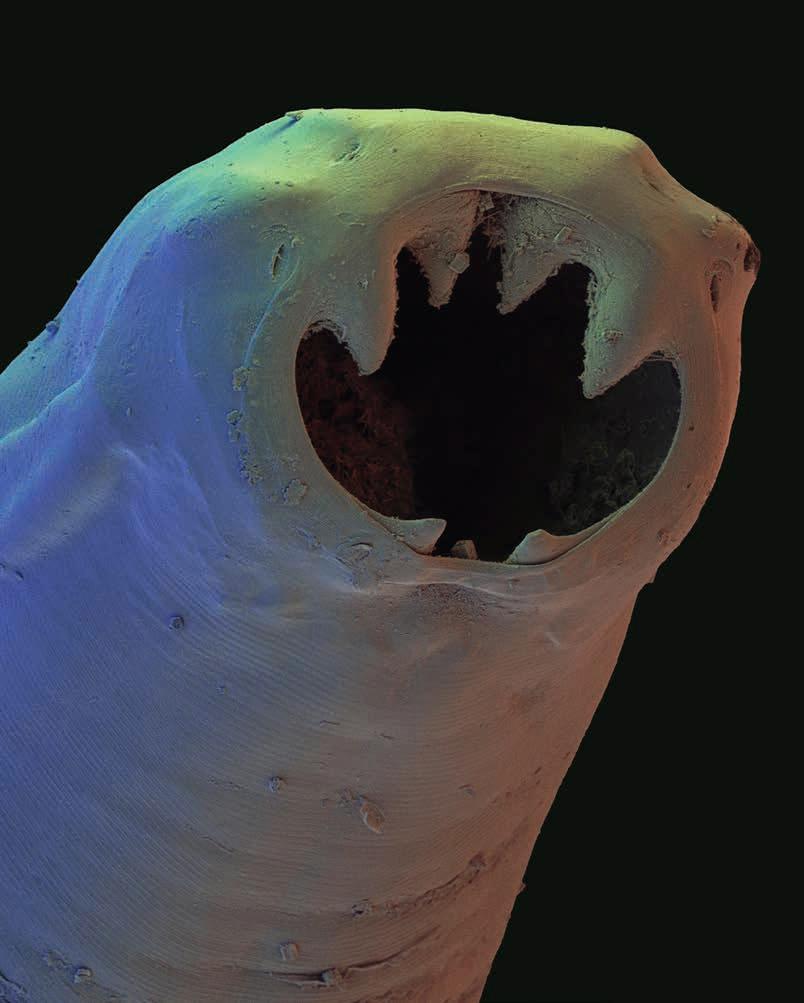
Medical Fiascoes Series





EARLY ONE MORNING IN NOVEMBER 1908, A TRAIN SLOWED down to pick up passengers at a southern railroad station. Peering through his railcar’s window, a traveler from Iowa pointed to a deathly pale, hunchedover figure standing on the station platform.

“What on earth is that?” he asked his two companions, wondering what could make a young man look so emaciated and broken down.
His friend, who had grown up in the South, explained that the man was probably one of the local tenant farmers.
The Iowan was shocked. He was used to the robust look of midwestern farmers. “If he represents Southern farm labor the South is in poor luck,” he said.
The third traveler, a scientist, had seen many similar people. In fact, he had been studying them for several years, and he knew exactly what was wrong with the man on the platform. He informed his friends that they were looking at a victim of America’s bloodsucking murderer.
This vampire thrived in the warm southern climate. It lurked on the ground outside rural homes, schools, and churches. Invisible to its potential victims, it waited until
“The disease . . . is primarily a ‘poor man’s’ malady.”
—Charles Stiles, American scientist
one of them passed by. Undetected, it hitched a ride, burrowed in through the skin, and tricked the person’s body into allowing it to stay. The intruder hid deep in the host’s gut for years, anchored in place by sharp fang-like mouthparts.
Day by day, one drop at a time, the vampire devoured blood from its unsuspecting victim. At first the person suffered few ill effects. But when more invaders followed —and they usually did—his or her body became home to hundreds, sometimes thousands, of the tiny creatures.
Before long, the daily blood loss was enough to weaken and sicken the host. The person was transformed into a dull-witted, frail individual with a blank stare and shuffling gait—just like the man on the platform.
The scientist had learned many of the American Murderer’s secrets. He understood how it attacked the human body. He was aware of the damage it did. And he was convinced the vampire could be stopped—must be stopped!—from slowly sucking the life and energy out of millions of men, women, and children. He was determined to end this medical fiasco—one that most of America didn’t know existed.
“The
CHARLES WARDELL STILES’S FATHER AND GRANDFATHER expected him to become a minister. They both had devoted their careers to preaching from Methodist pulpits, and it seemed natural to them that he would do the same. Charles had his own ideas. He was fascinated by animals, not religion.
Charles was born on May 15, 1867, in Spring Valley, New York, a small town north of New York City. He spent his boyhood exploring the nearby woods and fields, where he gathered specimens for his bedroom nature museum. Charles had collections of bugs, butterflies, and other creatures—both dead and alive. Curious about what was inside an animal’s body, he dissected frogs and earthworms.
One day he found a dead cat in a vacant lot and decided to add its skeleton to his museum. First he removed the cat’s fur, flesh, and organs. In order to detach
little worm . . . has acquired a bad reputation lately.”
—E. Bugnion, Swiss physician
the muscles from the bones, Charles realized he’d have to boil down the rest. Since no one was home to object to his plan, he filled one of his mother’s large pots with water, put it on the stove, and dumped in the cat’s remains. With the water on a slow boil, Charles went outside to play with a friend. He forgot about the pot on the stove until he smelled a stench and saw smoke coming from the kitchen.
Charles didn’t get the new addition to his museum as he hoped. The water had boiled off, and the cat skeleton was burned into a foul mess.
Growing up in a minister’s household, Charles had to follow certain rules. Sunday was reserved for religious activities. He was permitted to devote the hours after church services to singing hymns, walking and reflecting in the graveyard, or reading the Bible. Forced to choose, Charles opted for reading.
To make the task less boring, he turned it into a puzzle. Using the French he’d learned in school, he translated a French Bible into English as he read. Charles liked the challenge so much that he spent his Sunday afternoons translating German, Latin, Italian, and Greek Bibles. Although he didn’t realize it at the time, this knowledge of languages would later prove useful.
Right before Charles entered high school, he moved with his parents and older sister to Hartford, Connecticut. He had good grades in his classes and excelled in languages, but Charles was more interested in playing baseball, football, and pranks than in studying.
On days off from school, he enjoyed helping out at a local surgeon’s practice. Medicine appealed to Charles, and the surgeon suggested that he go directly to medical school after high school. This was a path that potential doctors could take in the nineteenth century.
Yet when the time came, Charles respected his father’s wish that he attend Wesleyan University, a Methodist college in nearby Middletown, Connecticut, where his father once studied. Although Charles agreed to go, he had no intention of being a minister. He preferred science.
Charles’s college career there only lasted until the middle of his second year. He developed severe headaches, which he blamed on eyestrain from reading with poor light, and he had to return home. Eyeglasses ended his headaches, but the unexpected weeks away from Wesleyan led Charles to a decision. If he was going to pursue biology, he wanted to do it somewhere else.
The world’s best scientists taught at universities in Germany and France. Charles convinced his father that a European education would provide better training in biology and medicine than Wesleyan. With his family’s support, nineteen-year-old Charles sailed for Europe later that winter.
His language skills helped him adjust to lectures at several colleges in France and Germany. Within a few months, Charles enrolled at the University of Berlin, where he studied for two years.

After taking courses in zoology, botany, physics, chemistry, and anatomy, Charles decided he wanted to focus on animals, not humans. He was intrigued by worms that lived inside other animals, often causing harm to their host. The study of these parasites, called parasitology, was a new field of zoology. Determined to learn as much as possible, Charles left Berlin to train with the world’s parasitology experts at Germany’s University of Leipzig.
One of the worms he studied was named Ancylostoma duodenale, a member of a group known as hookworms. Hookworms gained their nickname because some types had hooklike structures on the tail end, which were part of the male’s reproductive organs. Charles learned from his professor, a leading authority on parasitic worms, that Ancylostoma duodenale had only been discovered about fifty years earlier.

In 1838, Italian doctor Angelo Dubini (1813–1902) performed an autopsy on a peasant woman in Milan as part of his research into disease causes. He noticed a tiny white worm, about one-third of an inch long (8 mm), attached by its mouth to the mucous wall of her small intestine. When he examined the worm under a microscope, Dubini realized that it was unlike any of the human intestinal worms previously described by scientists.
Four years later, during another autopsy, Dubini spotted the same kind of worm again. This time he used a more powerful microscope so that he could sketch the worm in detail. Inside its mouth were four toothlike structures that Dubini described as curved hooks.
Now alert to this new worm, he found it in other dead bodies, sometimes in great numbers. Eventually, he saw it in 20 of the 100 human cadavers he dissected in his further study of the worm. This creature wasn’t rare, but it was easy to miss. A doctor had to cut open the intestine and inspect the mucous lining carefully.
Dubini was aware that other parasitic worms could cause illness, usually because they were stealing nourishment from the host and using it for themselves. Yet the infected people he dissected had died from a variety of ailments. The only common symptom was weakness and emaciation, conditions that many hospital patients exhibit before they die.